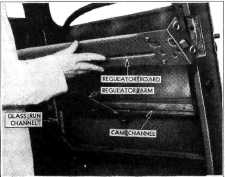1942 - 1947 CHEVROLET SHOP MANUAL
Section 1 Body
|
|
|||
|
1-39
|
|||
|
|
|||
|
The cab is further insulated at each rear mounting
bolt by a hard rubber bumper encased in a
metal retainer. The mounting bolt
passes through the center
of the rubber bumper and retainer, and
a heavy cushioning coil spring is
placed between the bolt
head and cab sill. The lower end of the
bolt passes through the top
channel of the frame side
rail and terminates in a castellated nut, locked
with a cotter pin.
The position of the rear center cab mounting
bolt is reversed from that of the
rear bolt in that the
cushioning spring is placed below the top
channel of the frame side rail and
between it and the
castellated retaining nut. The other two mounting
bolts are not spring-cushioned but fabric rubber
insulators are used between the
cab sill and frame upper
channel at each of these bolt positions.
The cushion spring method of mounting is designed
to permit the truck frame to weave under certain conditions
without placing undue strain on the cab structure. The cushion
mounting bolt retaining nuts
should only be tightened to a point
where it is just possible to
insert the cotter pin and no further. Greater tightening would
compress the springs to such an extent that flexibility would be
destroyed.
DOOR GLASS
A metal frame is
mounted on the door glass with the
conventional rubber filler strip; this frame reinforces the
glass and at the same time provides
freedom from looseness and
rattles.
Cab Door Glass Replacement
1. Remove
door lock handle, window regulator
and door lock remote control
handles.
2. Remove
the door inner panel screws and remove
the panel.
|
3. Remove
the screws attaching the regulator
board, and tip it away from the
door. This disengages the
regulator from the cam channel, as
shown in Fig. 85.
4. Raise
the glass and remove the glass run
channel from its retainers on the
lock pillar side, then
remove the glass.
5. To
install the metal channels, place a length of
rubber filler strip over the edge
of the glass, then tap the
channel over the glass and filler
strip; trim the filler flush with
the channel using a sharp
knife or safety razor blade.
6.
Install the glass in the door
opening, lubricate the cam channel with graphite grease, connect
the regulator to the cam
channel, as shown in Fig.
G5. Reassemble the regulator board, door inner panel, and control
handles.
When the door glass is removed, a glass run
channel may be replaced by
removing the garnish
molding and then removing the screw which
anchors the top of the channel.
Door Lock and Glass Regulator Replacement
A door lock or window
regulator may be easily replaced when the regulator board is removed
from the door, as these parts are
mounted on the regulator board by screws.
WINDSHIELD
Windshield Glass Replacement
1. Remove
the three regulator arm bracket screws at the windshield frame.
2. Remove
the windshield hinge screws, two on
each side at top of windshield
frame.
3. Remove
the three screws from the top and bottom
reinforcing plates, then remove the four screws from the center
division channel and remove the
inner and outer channels with their seals.
4. Remove
the screws attaching the top and bottom
channels to the frame reinforcement on one
side of the center division
channel. Then pull the two
halves of the windshield apart at the
center, as shown in Fig. 86.
5. When
replacing a windshield glass, place a strip
of Everseal filler channel over
the edge of the glass, with
the soap-stoned side out. Brush the
inside of the windshield channel
with light lubricating oil.
Push the glass with the channel
tiller into the windshield
channel by hand.
NOTE-The oil acts
on the channel filler, causing it to swell, thereby making a perfect
watertight seal.
6. Assemble
the windshield halves and install the
screws in the center
reinforcement.
|
||
 |
|||
|
Fig. 85-Truck
Cab Door Parts
|
|||
|
|
|||